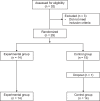Elite Female Basketball Players' Body-Weight Neuromuscular Training and Performance on the Y-Balance Test
- PMID: 27824252
- PMCID: PMC5139785
- DOI: 10.4085/1062-6050-51.12.03
Elite Female Basketball Players' Body-Weight Neuromuscular Training and Performance on the Y-Balance Test
Abstract
Context: Neuromuscular training enhances unconscious motor responses by stimulating both the afferent signals and central mechanisms responsible for dynamic joint control. Dynamic joint-control training is a vital component of injury-prevention programs.
Objective: To investigate the effects of body-weight neuromuscular training on Y-Balance Test (YBT) performance and postural control in female basketball players.
Design: Randomized controlled clinical trial.
Setting: Basketball practice sessions.
Patients or other participants: A total of 28 healthy elite female basketball players were randomly assigned to an experimental (n = 14) or a control group (n = 14).
Intervention(s): Before their regular practice sessions, the experimental group warmed up with body-weight neuromuscular exercises and the control group with standard tactical-technical exercises twice weekly for 8 weeks.
Main outcome measure(s): Anterior-, posteromedial-, and posterolateral-reach and composite YBT scores were measured before and after 8 weeks of training.
Results: Improvement over baseline scores was noted in the posteromedial (right = 86.5 ± 4.5 cm versus 89.6 ± 2.2 cm, +3.5%, P = .049; left = 85.5 ± 4.3 cm versus 90.2 ± 2.7 cm, +5.5%, P = .038)- and posterolateral (right = 90.7 ± 3.6 cm versus 94.0 ± 2.7 cm, +3.6%, P = .016; left = 90.9 ± 3.5 cm versus 94.2 ± 2.6 cm, +3.6%, P = .011)-reach directions and in the composite YBT scores (right = 88.6% ± 3.2% versus 94.0% ± 1.8%, +5.4%, P = .0004; left = 89.2% ± 3.2% versus 94.5% ± 3.0%, +5.8%, P = .001) of the experimental group. No differences in anterior reach were detected in either group. Differences were noted in postintervention scores for posteromedial reach (right = 89.6 ± 2.2 cm versus 84.3 ± 4.4 cm, +4.1%, P = .005; left = 94.2 ± 2.6 cm versus 84.8 ± 4.4 cm, +10%, P = .003) and composite scores (right = 94.0% ± 1.8% versus 87.3% ± 2.0%, +7.1%, P = .003; left = 94.8% ± 3.0% versus 87.9% ± 3.4%, +7.3%, P < .0001) between the experimental and control groups.
Conclusions: Body-weight neuromuscular training improved postural control and lower limb stability in female basketball players as assessed with the YBT. Incorporating neuromuscular training into the workout routines for basketball players may enhance joint awareness and reduce the risk of lower extremity injury.
Keywords: core stability; lower limb stability; plyometric exercises.
Figures




References
-
- Ziv G, Lidor R. Physical attributes, physiological characteristics, on-court performances and nutritional strategies of female and male basketball players. Sports Med. 2009; 39 7: 547– 568. - PubMed
-
- McInnes SE, Carlson JS, Jones CJ, McKenna MJ. The physiological load imposed on basketball players during competition. J Sports Sci. 1995; 13 5: 387– 397. - PubMed
-
- Harmer PA. Basketball injuries. Med Sport Sci. 2005; 49: 31– 61. - PubMed
Publication types
MeSH terms
LinkOut - more resources
Full Text Sources
Other Literature Sources
Medical

